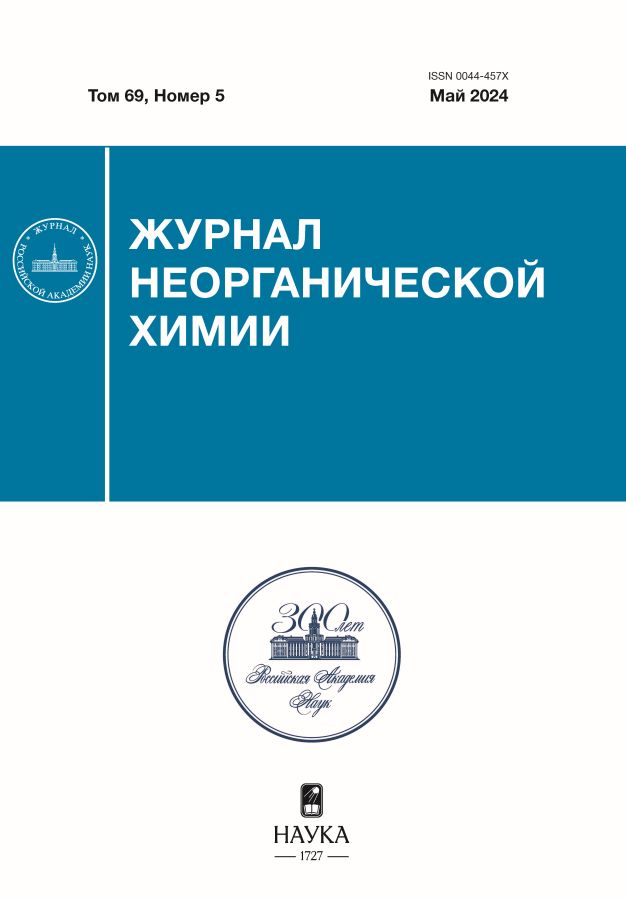Spin properties of silicon-germanium nanotubes
- 作者: D’yachkov Е.P.1, Merinov V.B.1,2, D’yachkov P.N.1
-
隶属关系:
- Kurnakov Institute of General and Inorganic Chemistry
- National Research Nuclear University “MEPhI”
- 期: 卷 69, 编号 5 (2024)
- 页面: 757-764
- 栏目: ТЕОРЕТИЧЕСКАЯ НЕОРГАНИЧЕСКАЯ ХИМИЯ
- URL: https://innoscience.ru/0044-457X/article/view/666544
- DOI: https://doi.org/10.31857/S0044457X24050145
- EDN: https://elibrary.ru/YENDVL
- ID: 666544
如何引用文章
详细
The dependence of the electronic structure on the chirality of single-walled SiGe nanotubes has been studied using the quantum chemistry methods. It has been shown that all nanotubes have a semiconductor type of band structure with a band gap Eg of about 0.35 eV, which distinguishes them from silicon analogues, which, depending on chirality, have semiconductor, semimetallic or metallic properties. This difference is due to the polarity of the Si-Ge chemical bond and, as a consequence, the influence of the antisymmetric component of the electronic potential on the band structure of the compounds. The valence band with a width of about 12 eV includes an inner band of predominantly s electrons of atoms with a width of 2 eV and a band of p electrons located above with a width of 8 eV. The energies of the spin-orbit gaps of the edges of the valence band and the conduction band differ significantly: for non-chiral nanotubes, they are equal to several tenths, and for chiral nanotubes, they are several meV. Using mechanical action, for example, by twisting a nanotube around its axis, it is possible to control the energies of spin-orbit gaps, which can find application in spintronics.
作者简介
Е. D’yachkov
Kurnakov Institute of General and Inorganic Chemistry
Email: p_dyachkov@rambler.ru
俄罗斯联邦, Moscow
V. Merinov
Kurnakov Institute of General and Inorganic Chemistry; National Research Nuclear University “MEPhI”
Email: p_dyachkov@rambler.ru
俄罗斯联邦, Moscow; Moscow
P. D’yachkov
Kurnakov Institute of General and Inorganic Chemistry
编辑信件的主要联系方式.
Email: p_dyachkov@rambler.ru
俄罗斯联邦, Moscow
参考
- Lin N., Wang L., Zhou J. et al. // J. Mater. Chem. A. 2015. V. 3. P. 11199. https://doi.org/10.1039/C5TA02216A
- Yu Y., Yue C., Sun S. et al. // ACS Appl. Mater. Interfaces. 2014. V. 6. P. 5884. https://doi.org/10.1021/am500782b
- Kennedy T., Bezuidenhout M., Palaniappan K. et al. // ACS Nano. 2015. V. 9. P. 7456. https://doi.org/10.1021/acsnano.5b02528
- Xiao W., Zhou J., Yu L. et al. // Angew. Chem. Int. Ed. 2016. V. 55. P. 7427. https://doi.org/10.1002/anie.201602653
- Seifert G., Kohler T., Hajnal Z. et al. // Solid State Commun. 2001. V. 119. P. 653. https://doi.org/10.1016/S0038-1098(01)00309-X
- Fagan S.B., Baierle R.J., Mota R. et al. // Phys. Rev. B. 2000. V. 61. P. 9994. https://doi.org/10.1103/PhysRevB.61.9994
- Herrera-Carbajal A., Rodrıguez-Lugo V., Hernandez-Avila J. et al. // Phys. Chem. Chem. Phys. 2021. V. 23. P. 13075. https://doi.org/10.1039/D1CP00519G
- Rathi S.J., Ray A.K. // Chem. Phys. Lett. 2008. V. 466. P. 79. https://doi.org/10.1016/j.cplett.2008.10.031
- Liu X., Cheng D., Cao D. // Nanotechnology. 2009. V. 20. P. 315705. https://doi.org/10.1088/0957-4484/20/31/315705
- Pan L., Liu H., Wen Y. et al. // J. Comput. Theor. Nanosci. 2010. V. 7. P. 1935. https://doi.org/10.1166/jctn.2010.1563
- Wei J., Liu H.J., Tan X.J. et al. // RSC Adv. 2014. V. 4. P. 53037. https://doi.org/10.1039/C4RA07320G
- Dadrasi A., Albooyeh A., Mashhadzadeh A.H. // Appl. Surf. Sci. 2019. V. 498. P. 143867. https://doi.org/10.1016/j.apsusc.2019.143867
- Yang S.H. // Appl. Phys. Lett. 2020. V. 116. P. 120502. https://doi.org/10.1063/1.5144921
- Yang S.H., Naaman R., Paltiel Y. et al. // Nature Rev. Phys. 2021. V. 3. P. 328. https://doi.org/10.1038/s42254-021-00302-9
- Michaeli K., Kantor-Uriel N., Naamanm R. et al. // Chem. Soc. Rev. 2016. V. 45. P. 6478. https://doi.org/10.1039/C6CS00369A
- Naaman R., Waldeck D.H. // Annu. Rev. Phys. Chem. 2015. V. 66. P. 263. https://doi.org/10.1146/annurev-physchem-040214121554
- Manchon H., Koo H.C., Nitta J. et al. // Nat. Mater. 2015. V. 14. P. 871. https://doi.org/10.1038/nmat4360
- Koo H.C., Kim S.B., Kim H. et al. // Adv. Mater. 2020. V. 32. P. 2002117. https://doi.org/10.1002/adma.202002117
- Bercioux D., Lucignano P. // Rep. Prog. Phys. 2015. V. 78. P. 106001. https://doi.org/10.1088/0034-4885/78/10/106001
- D’yachkov P.N., D’yachkov E.P. // Appl. Phys. Lett. 2022. V. 120. P. 173101. https://doi.org/10.1063/5.0086902
- D’yachkov P.N., Lomakin N.A. // Russ. J. Inorg. Chem. 2023. V. 68. № 4. P. 492. https://doi.org/10.1134/S0036023622602823
- D’yachkov E.P., Lomakin N.A., D’yachkov P.N. // Russ. J. Inorg. Chem. 2023. V. 68. № 7. P. 855. https://doi.org/10.1134/S0036023623600867
- D’yachkov P.N., D’yachkov E.P. // Russ. J. Inorg. Chem. 2023. V. 68. № 10. P. 1446. https://doi.org/10.1134/S0036023623601897
- Slater J.C. // Phys. Rev. 1937. V. 10. P. 846. https://doi.org/10.1103/PhysRev.51.846
- Andersen O.K. // Phys. Rev. B. 1975. V. 12. P. 864. https://doi.org/10.1103/PhysRevB.12.3060
- Koelling D.D., Arbman G.O. // J. Phys. F: Metal Physics. 1975. V. 5. P. 2041. https://doi.org/10.1088/0305-4608/5/11/016
- D’yachkov P.N., Makaev D.V. // Phys. Rev. B. 2007. V. 76. P. 19541. https://doi.org/10.1103/PhysRevB.76.195411
- D’yachkov P.N., Makaev D.V. // Int. J. Quantum Chem. 2016. V. 116. P. 316. https://doi.org/10.1002/qua.25030
- D’yachkov P.N. Quantum chemistry of nanotubes: electronic cylindrical Waves. London: CRC Press, 2019. 212 p.
- Дьячков П.Н. Электронные свойства и применение нанотрубок. М.: Лаборатория знаний, 2020. 491 с.
补充文件









